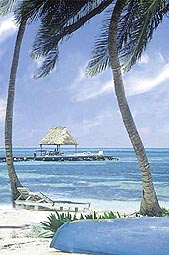|
|
|
|
Located in Central America, bordering the Caribbean Sea,
Guatemala is situated between Honduras and Belize and bordering the
North Pacific Ocean, between El Salvador and Mexico.
For nine evenings prior to Christmas, the beat of drums and the
explosion of fireworks are heard as posada (“inn”) processions move
through the streets of Guatemala, with participants carrying farolitos
(small tin lanterns) to light the way. On each of these posadas, which
are re-enactments of Joseph’s and Mary’s search for shelter in Bethlehem
before Jesus’ birth, figures of the couple are carried to a designated
house as special carols are sung and ritual questions and answers are recited.
The figures are then placed on the nacimiento or Nativity scene
of the house, where they will remain until the following night when the
search for shelter resumes, and a great party takes place with food,
drink, music, and dancing.
As in other countries, Guatemalans adorn their homes during
Christmas with lights and assorted decorations. Setting up the
nacimiento, the custom of which was introduced to the country
by the Franciscans during the 17th century, is truly a family
affair. Structures and human and animal figures used in the
nacimiento are usually made of clay, wood, or plaster, while
fields and roads are made of colored sawdust.
Tamales made with pork or chicken are the most popular
Christmas dish in Guatemala (one Guatemalan website on the Internet
claims, in fact, that “a Christmas without tamales is not Christmas”).
Guatemalans also enjoy different punch drinks with ingredients such
as dried fruit, raisins, prunes, dates, cinnamon, milk, and/or rum.
In 2006, a visitor to this site who lived in Guatamala for more than four decades e-mailed the following information: The tradition of giving out presents on the 6th of Jan (3 wise men) is a European celebration that Guatemala, being a Spanish colony, observed for a long time. Due to other influences that tradition has been lost a lot. You will see the 6th of January celebrations in small towns that stay with the old traditions.  Song: Caribbean Bugler's Holiday |
Please sign the Guest Book